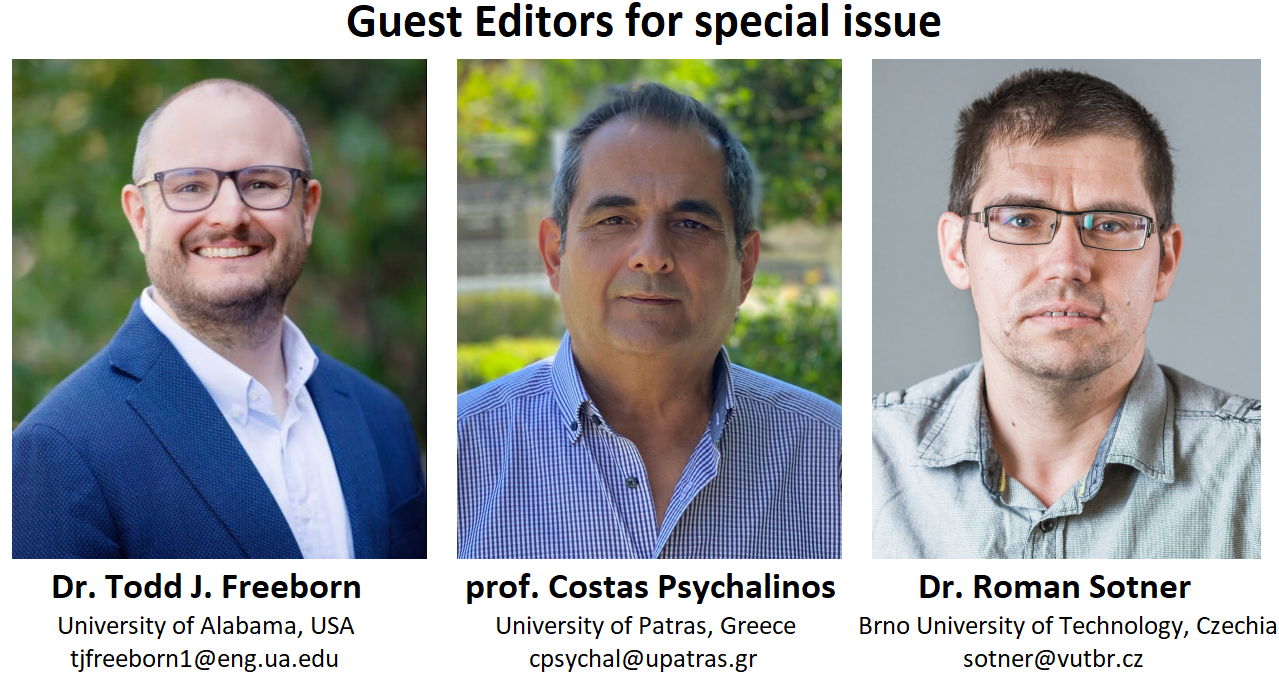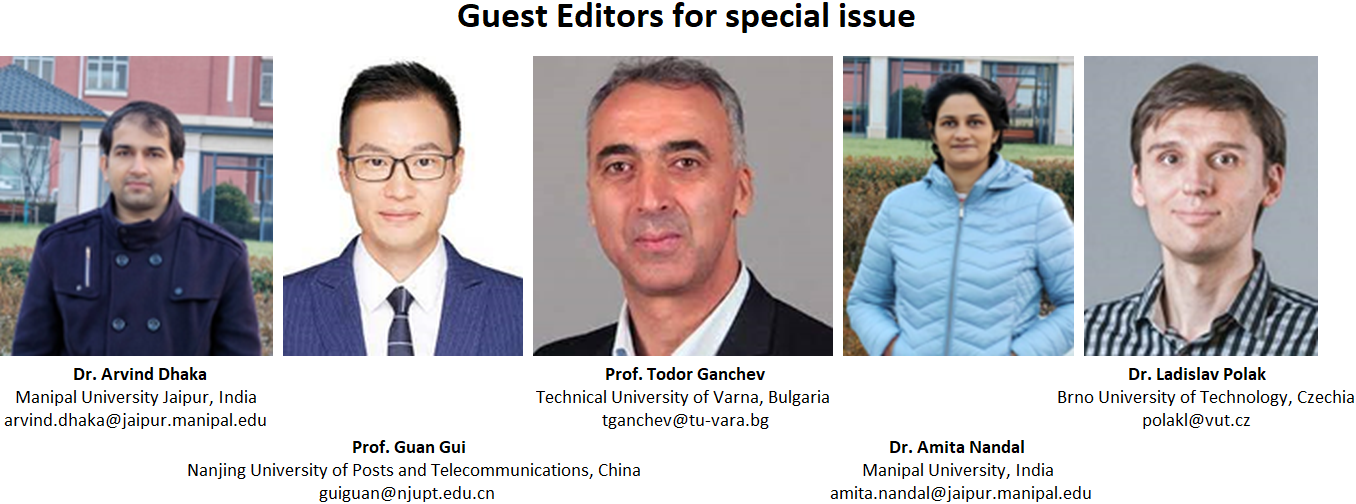Opened special issues
The last special issue (SI) published in the Radioengineering Journal dates back to the year 2015. This SI was focused on the emerging topic of memristors and their applications. The papers published within this SI were authored by leading experts in the field, such as Prof. Chua, Prof. Biolek, Prof. Tetzlaff, and many others. These papers have already received numerous citations, making the SI highly successful.
Now, after eight years, the editorial staff of the Radioengineering Journal has decided to open a new limited number of SIs. The topics for these SIs will be carefully selected with respect to scientific soundness, application potential, and impact on the engineering community.
The journal's editorial staff offers a very fast review process, with a maximum duration of two weeks to reach a first-round decision. This process is led by distinguished experts who specialize in the research areas of the respective SI. Additionally, papers accepted for any SI will receive a 20% discount, reducing the final publication fee to 320 EUR. To apply this discount, authors of accepted papers must contact chief editor chief@radioeng.cz before generation of invoice. It is important to note that an SI does not represent a closed journal volume or number, as accepted papers will still be published on-the-fly.
Please read important note here. To start regular review process, all papers must be uploaded via online submission system of the Radioengineering journal. The authors of papers must use the recommended journal template in MS Word Template DOC or Tex Template TEX. Papers prepared in another journal template will be automatically rejected!
1: Fractional-Order Circuits and Systems
“Circuits and systems” refer to the field encompassing all topics relating to the design, analysis, and implementation of electrical circuits. Electrical circuits are the foundation upon which all smart devices, wireless communications, automotive systems, power systems, and healthcare devices are built. An emerging area of active research is referred to as fractional-order circuits and systems, which incorporate concepts from fractional calculus into modeling and design. These concepts, focused on non-integer order differentiation and integration mathematical operations, are being explored across many fields of science and engineering. Focusing on their integration into circuits and systems, these concepts are being used to design analog filter circuits, oscillators, and control systems to name a few of their recent applications. Additionally, the use of circuit elements with fractional-order impedances are being widely explored to model the electrical characteristics of biological materials and energy storage devices (e.g. supercapacitors, batteries). There is also increased focus on the design and fabrication of fractional-order circuit components to support their transition from theoretical design to practical implementations.
The focus of this special issue is to continue to advance research on topics relating to the theory, design, implementation, and application of fractional-order circuits and systems. Topics that are invited for submission include (but are not limited to):
• Fractional-order circuit theory;
• Fractional-order filter and oscillator designs and realizations;
• Fractional-order control systems and implementations;
• Approximations for the simulation and realization of fractional-order systems;
• Active and passive designs of fractional-order elements;
• Applications of fractional-order circuit models for biology and biomedicine;
• Applications of fractional-order circuit models for energy storage elements;
• Comprehensive reviews of recent progress in fractional-order circuits and systems.
Prospective contributors are asked to write a note in cover letter that their paper belongs to the SI: Fractional-Order Circuits and Systems during the initial paper upload process. Deadline for initial paper submission is 1st July 2024. Here, you can find, download and distribute document Call for Papers.

2: AI-Driven Secure Communication in Massive IoT for 5G and Beyond
The rapid growth of the Internet of Things (IoT) has increased the potential for the collection, sharing, and analysis of massive amounts of data. Consequently, there is a growing need for secure communications to safeguard sensitive data and ensure privacy. For this purpose, among others, different methods and algorithms of Artificial Intelligence (AI) can be used. AI-driven secure communication in massive IoT for fifth generation (5G) wireless communication and beyond holds significant potential for enhancing security across various applications. This technology can enable secure communication in large-scale and heterogeneous networks, ensuring end-to-end security and privacy.
Authentication represents a pivotal challenge in AI-driven secure communication within the realm of massive IoT for 5G and future technologies. It plays a crucial role in ensuring that solely authorized devices gain access to the network, thereby fortifying its defenses against malicious entities. Leveraging AI, machine learning algorithms can enhance authentication processes by detecting and thwarting malicious activities. End-to-end encryption stands as a fundamental requirement for secure communication within IoT networks. By employing AI, the encryption process can be actively monitored to identify and address vulnerabilities and potential malicious endeavors. Furthermore, the detection of anomalous behaviors within IoT networks poses potential security threats. Through the application of AI, machine learning algorithms can be utilized to identify patterns in the data, enabling the detection of suspicious activities.
This call for papers aims to solicit original contributions in the field of AI-Driven Secure Communication in Massive IoT for 5G and beyond. We cordially invite submissions of research papers that tackle challenges, propose new solutions, and/or significantly improve existing approaches within this domain. Topics that are invited for submission include (but are not limited to):
• AI-assisted secure communication for massive IoT networks;
• Security challenges in massive IoT networks and AI-based solutions;
• Secure network requirements for massive IoT with AI-driven communication;
• Design of AI-based secure protocols for massive IoT;
• Security and privacy challenges in 5G and beyond massive IoT networks;
• AI-driven secure data sharing in massive IoT networks;
• Secure network architecture for massive IoT with AI-assisted communication;
• Role of AI in secure communication for massive IoT networks;
• AI-driven authentication and authorization mechanisms for massive IoT networks.
Prospective contributors are asked to write a note in cover letter that their paper belongs to the SI: AI-Driven secure communication in massive IoT during the initial paper upload process. Deadline for initial paper submission is 1st September 2024. Here, you can find, download and distribute document Call for Papers.

3: Machine Learning for Cloud-Edge Emerging Network Architectures: Theories, Foundations, Applications and Challenges
Machine learning offered solution to problems by teaching the machine to learn instead of the conventional programming. Machine learning has been delivering promising solutions to the cloud computing environment in real world scenario. The challenges of the traditional cloud computing platforms, among others, are follows: low communication latency, energy consumption, geographical separation of the user devices and cloud data centres, low quality of service and low quality of experience triggered by the traditional cloud computing challenges, very high number of request in the data centre networks, indirect accessibility of user location, local network and user mobility ushered the emergence of the emerging cloud architectures (edge computing, fog computing, volunteering computing, serverless computing and software defined computing to find solutions to the traditional cloud computing paradigm). It is expected that in the future, the emerging cloud architectures will affect the society and the scientific community. The network edge will provide services to the distributed infrastructure of the cloud. It is also expected to develop a new marketplace for the resources of the edge network and multi-tier architectures will replace the conventional two-tier applications. Other challenges of the emerging cloud architectures include but not limited to: sustainability, reliability, express activities and management.Machine learning approaches have started gaining attention in building solution to problems in the emerging cloud architectures. Though, the application of the machine learning approaches in the emerging cloud architectures is in infant stage with many issues yet to be attended to by the machine learning approaches. Similarly, many machine learning approaches are yet to be applied to solve problems in the emerging cloud architectures. The integration of the machine learning in the emerging cloud architectures for solutions could be in the form of supervise, semi-supervise, unsupervised and reinforcement learning. Different machine learning algorithms suit different techniques, for example supervise learning (artificial neural networks), unsupervised (k-nearest neighbour), semi-supervise (graph learning convolutional network), reinforcement learning (Q-Network) etc. Deploying machine learning algorithms for solution in emerging cloud architectures can create a robust intelligent environment to handle dynamic situations for improving efficiency and effectiveness of the emerging cloud architectures.
The purpose of this special issue aims to offer a diverse and emerging solutions, but complementary set of significant contributions to demonstrate new developments of machine learning solutions to solve real world problems in the emerging cloud architectures. The goal is to promote research and development of machine learning based solutions in the emerging cloud architectures by publishing very high-quality technical articles, extended conference papers with significant new results (minimally 70% of new results), and surveys/tutorials within this domain.
Topics that are invited for submission include (but are not limited to):
• Machine learning for evaluating energy efficiency in networks for the emerging cloud architectures.
• Machine learning and artificial intelligence for edge computing quality of experience (QoE) management.
• Deep learning architectures (for instance dense neural network, convolutional neural network, deep belief network etc.) for resource allocation/QoE in emerging cloud architectures paradigm.
• Deep learning processing of images in the emerging cloud architecture platforms (e.g., edge, serverless, volunteering, etc.).
• Nature-Inspired meta-heuristic algorithms for aiding decision in emerging cloud architectures.
• Nature inspired meta-heuristic algorithms for training of deep learning models in the context of emerging cloud architectures.
• Hybrid machine learning systems for edge/serverless computing context-aware systems.
• Deep learning detection of server failures in an environment of emerging cloud architectures.
• Machine learning automation of decision in software defined computing.
• Knowledge-based discovery with nature-inspired meta-heuristic algorithms in fog/edge computing for quality of service (QoS).
• Harnessing recommender systems in a new marketplace for resources at the edge of the network in the emerging cloud architectures.
• Innovation in deep learning algorithms for emerging cloud architectures data analytics.
• Deep learning models in fog computing for enhancing QoS.
• Machine learning based multi-party model for pricing in the emerging cloud architectures.
• Surveys and tutorials, case studies (including collaboration between academia and industry) and the current state of industrial practice in the emerging cloud architectures.
Prospective contributors are asked to write a note in cover letter that their paper belongs to the SI: Machine learning for cloud-edge emerging network architectures during the initial paper upload process. Deadline for initial paper submission is 31st October 2024. Here, you can find, download and distribute document Call for Papers.
